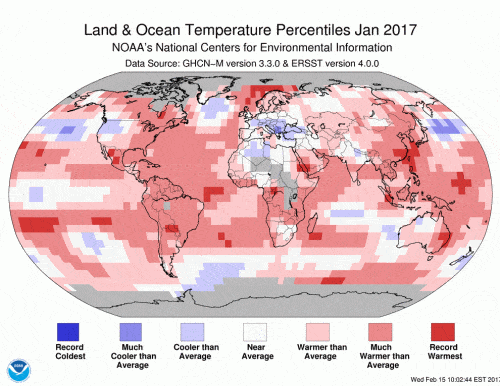The beginning of 2017 is also distinctly warmer than the global average

By Dr. Daniel Mader, Angle, Science and Environment News Agency
The year 2014 was the year in which the average global temperature was the highest since measurements began in the 19th century. 2015 broke this record and was the hottest. 2016 also smashed these two records, And it was the hottest (0.99 degrees Celsius above the 20th century average). And what about 2017?
In Israel, December 2016, January 2017 and February 2017 were colder than average months. The night temperatures measured in February were the lowest in the last 20 years. However, despite the relative cold in little Israel, the world is still warming. Despite the global warming trend, all regions of the world still have, and are expected to have, colder than average periods. The warming is not uniform in time (there may still be colder months and years than average) or in space (there may be certain areas that will actually cool compared to the past).
The average global temperature over the years
globally, January 2017 was 0.88 degrees Celsius warmer than the 20th century average. This is the third warmest January since measurements began in 1880 (January 2016 was the warmest, and January 2007 the second warmest). פברואר 2017 was 0.98 degrees Celsius warmer than average and is the 386th consecutive month that the global temperature has been above the 20th century average. The last time there was a month with a below-average global average temperature occurred in late 1984. Most of the global warming has occurred in the past 35 years, with 16 of the 17 warmest years occurring since 2001.
the poles Definitely feel this warming. The Arctic reached its peak winter ice extent on March 7, the lowest since records began (1979). This is in continuation of the permanent decrease in the area of the ice in the North Pole in the last decades. In the South Pole, on the other hand, the trend in the last decades has been a very moderate increase in the sea ice area. At the same time, in 2016 and early 2017, the sharpest drop in sea ice extent since records began in 1979 appeared. It is possible that the weather that led to this dramatic decrease is also responsible for the fact that a significant part of the ice shelf to Bridle C in Antarctica expected to collapse In the coming months (the length of the crack today is about 175 kilometers, with another 20 kilometers of ice still holding it). Relative to the average between 2010-1981, the amount of ice lost at both poles in the last 40 years is equal in area to the area of Mexico (two million square kilometers).
The status of the poles is as of March 7, 2017
